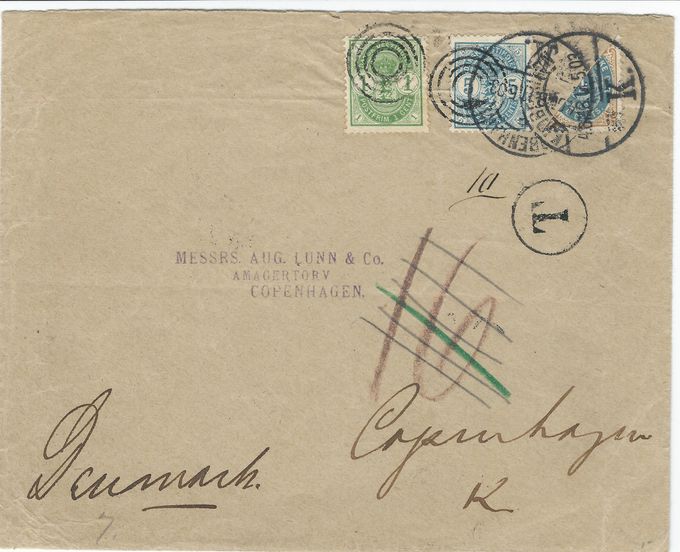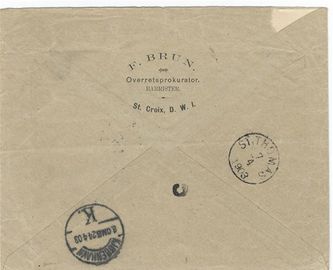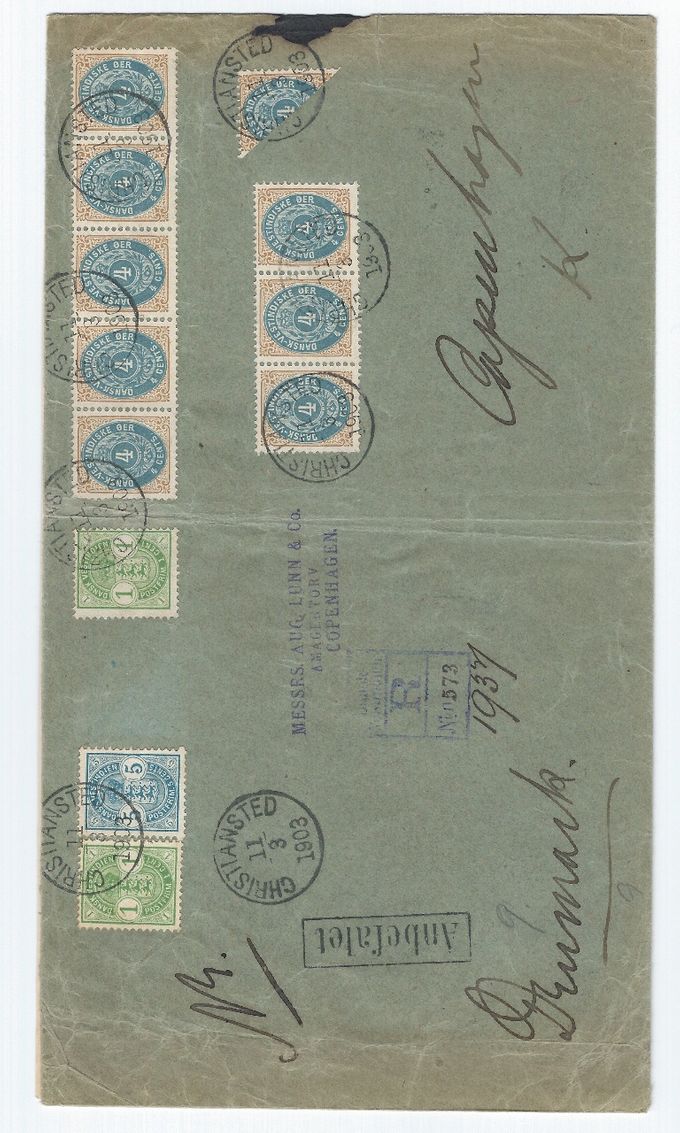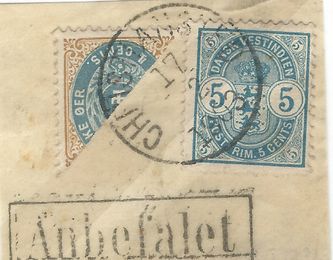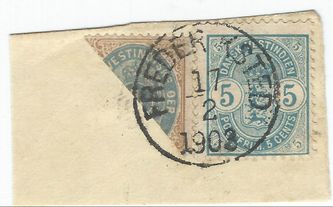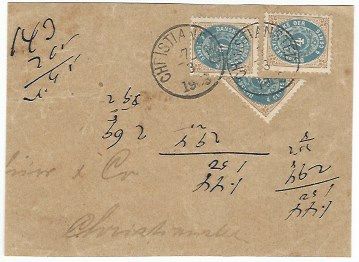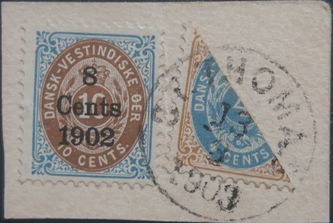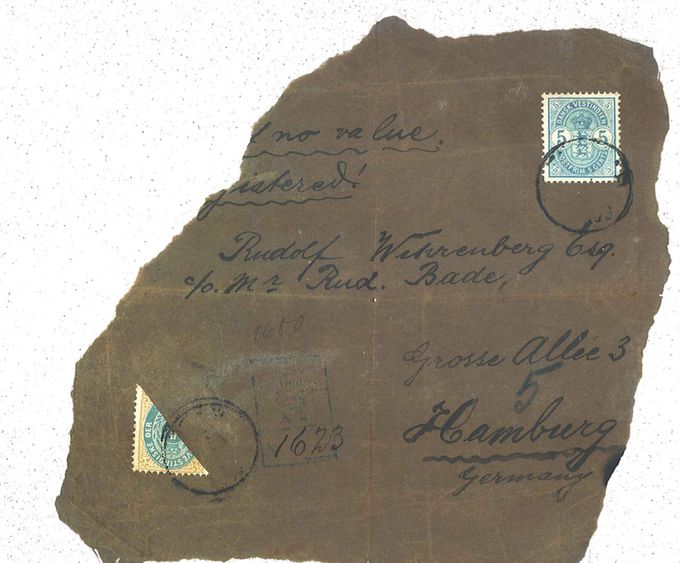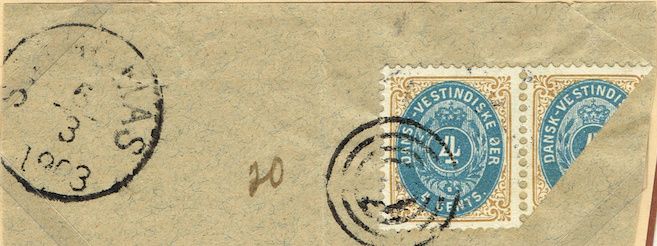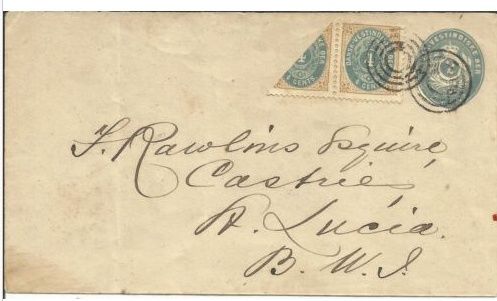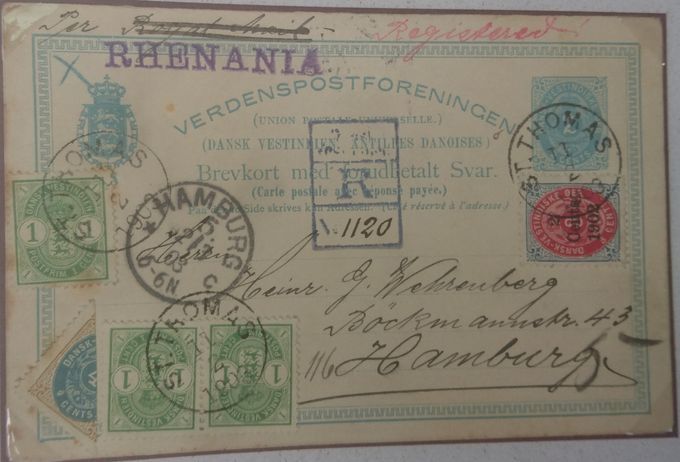UNAUTHORIZED USE OF BISECTED STAMPS
The St.Thomas Post Office used a 4 rings cancel to cancel stamps on mail that arrived without a cancel. It is seen on approximately 1% af bisected mail.
Franked with 1 cent - 5 cents and a bisected -total of 8 cents.
The letter has the 4 rings ship postmark and a "C" on the back and an arrival postmark St.Thomas April 7.
The bisected stamp was not accepted because the bisected could not be used with other stamps, therefore stamped "T"
On Convention in Paris in 1878 - it was decided that lack of postage (in centimes) were applied in black numbers next to the stamps. The post office in København (Copenhagen) would then charge double porto converted to Danish currency.
Not Accepted (missing postage) 2 cents - 10 centimes was applied - "16 øre in red". The 1 cent and 5 cents stamps were accepted for 6 cents.
In Copenhagen - there was uncertainty about the rules for using bisected stamps with other stamps and as they had previously been asked to repay not accepted porto - the bisected was accepted and stamped Kjøbenhavn April 24 1903.
REGISTERED MAIL AND OTHER COMBINATION USES
Franked with 42 cents - Anbefalet (Registered) from Christiansted March 11 1903 to Copenhagen. Backstamped St.Thomas March 14 and Copenhagen. Printing 3. A very rare - and perhaps unique cover.
Partial cancelled Christiansted February 17 and stamped Anbefalet (Danish for Registered). A unique partial.
The post office had specified that the bisected stamp could not be used in combinations with any other stamps to pay postage in excess of 2 cents. This partial canceled Christiansted February 17 is an exception since the 5 cents stamp was used
to pay the registration fee. There are very few examples of a bisected stamp used on registered mail and with the registry cancel “Anbefalet” (the large partial further below has a hand written "Registered" and a blue registration mark - but not
the cancel "Anbefalet").
Printing 4 and used within the 1 cent stamp depletion period.
There are only three known partials where the bisected has been cancelled in combination with a 5 cents. The cover is lacking a Danish Registry mark (Anbefalet) which where only used in the Christiansted Post Office. The 5 cents would have paid the registration fee in addition to the 2 cents letter rate - but we will never know the full story.
Postmark Frederiksted February 17.
Victor Engstrom mentioned that there were no known examples of a bisected stamp used together with a registration fee (Anbefalet) - and that it was not known if that practice would have been accepted. Such a letter would have had a 5 cents stamp paying the registration fee in addition to a 2 cents letter rate. Such examples are now known - though it is partials and not a complete letter.
One has a registry cancel in danish "Anbefalet" next to the stamps. This registry cancel is only used in the Christiansted Post Office.
The other partial is from Frederiksted (see smaller photo) - the same date February 17 - but obviosuly lacking the Danish Registry (Anbefalet) marking.
LOCALLY MAILED PARTIAL WITH 10 CENTS TOTAL POSTAGE
Partial. Cancelled Christiansted March 7.
As previously mentioned the official instruction regarding the use of bisected stamps specified that a bisected stamp was not to be used together with other stamps on mail that required more than two cents postage.
Ten cents postage was required for local mail that weighed 61-75 gram. (5 weight class) That weight could have been met with two 5 cents stamps.
The letter is certainly sent from St.Thomas via mail boat (letter box) and was first stamped upon arrival in Christiansted. The Christiansted Post Office accepted the letter and cancelled the bisected as it originated from St. Thomas where bisected were authorized.
Since it is a partial it is not known, if the Christiansted Post Office did allov the use of a bisected stamp with other 4 cents stamps. If so it is a great rarity. However - it could also have been marked postage due which could have been noticed on that part of the wrapper which was removed. It may also be a deliberate overpayment of two or more cents.
Partial. Cancelled March 13 1903. Assuming a total of 10 cents postage to pay for local mail - weight class 61-75 gram - but we will never know. Bisected 4 cents combined with 8 cents 1902 on 10 cents provisional stamp. A rare partial.
St.Thomas, February-June 1903 - large cut from St.Thomas to Hamburg. Franked with 5 Cents Coat of Arms and 2 cents bisected tied by St.Thomas. This is part of a registered sample without value. Registration mark Danish West Indies R No. 1623 in blue. 2 Cents rate sample of no value - 5 cents registration fee (1.1.1902-14.7.1905) - a total of 7 cents rate. Correct franking (Frank Banke).
Locally mailed partial with 6 cents total postage. The letter is sent from Christiansted via mailship (letter box) to St.Thomas. It was only stamped upon arrival in St.Thomas. The St.Thomas Postoffice did not accept the bisected together with other stamps - therefore the bisected is not stamped.
This unique cover was destined for St. Lucia - B.W.I.. It shows the letter box St. Thomas 4 rings cancels as it went from Christiansted to St. Thomas and then to St. Lucia. The bisect was not cancelled as 5 cents postage was sufficient to pay for letters travelling within the 300 nautical miles zone (in this case counting the distance between the origin town Christiansted to St. Lucia).
Backstamped St. Thomas March 9 and Castries St. Lucia March 12. Also stamped with a 'C' showing the Christiansted origin. The stamped 4 cents shows the oval flaw with the "defected and rounded horizontal line of large 4". A bit tricky to see on this scan and when almost hidden behind the cancel.
Please read more about this cover in 300 NAUTICAL MILES
Del siden
